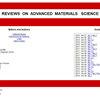具有定制介观结构的铁纳米粒子功能化有序介孔碳及其在磁性去除 Ag(i) 中的应用
IF 3.6
4区 材料科学
Q2 MATERIALS SCIENCE, MULTIDISCIPLINARY
引用次数: 0
摘要
以三嵌段共聚物为模板,通过溶剂蒸发自组装和碳热还原合成了铁纳米粒子功能化有序介孔碳(Fe0/OMC)。Fe0/OMC具有三种微观结构:二维六边形(空间群,p6mm,Fe0/OMC-1)、体心立方(Im3̄m,Fe0/OMC-2)和面心立方(Fm3̄m,Fe0/OMC-3),只需调整模板即可控制。所有的 Fe0/OMC 都显示出顺磁性特征,最大饱和磁化率为 50.1 emu-g-1。这种高磁化率有利于在吸附过程后迅速从溶液中提取吸附剂。用 Fe0/OMC 作为吸附剂从水溶液中去除银离子(Ag(i)),Fe0/OMC-1 的吸附能力因 Fe0 的功能化而增强。Fe0/OMC-1的吸附性能明显高于Fe0/OMC-2和Fe0/OMC-3,表明长而直的有序孔道更有利于吸附,Fe0/OMC-1对Ag(i)的吸附量为233 mg-g-1。吸附过程符合伪二阶动力学模型和 Freundlich 模型,表明吸附的主要机制是在异质表面上的多层吸附。本文章由计算机程序翻译,如有差异,请以英文原文为准。
Fe nanoparticle-functionalized ordered mesoporous carbon with tailored mesostructures and their applications in magnetic removal of Ag(i)
Fe nanoparticle-functionalized ordered mesoporous carbon (Fe0 /OMC) was synthesized using triblock copolymers as templates and through solvent evaporation self-assembly, followed by a carbothermal reduction. Fe0 /OMC had three microstructures of two-dimensional hexagonal (space group, p6mm, Fe0 /OMC-1), body centered cubic (Im3̄m, Fe0 /OMC-2), and face centered cubic (Fm3̄m, Fe0 /OMC-3) which were controlled by simply adjusting the template. All Fe0 /OMC displayed paramagnetic characteristics, with a maximum saturation magnetization of 50.1 emu·g−1 . This high magnetization is advantageous for the swift extraction of the adsorbent from the solution following the adsorption process. Fe0 /OMC was used as an adsorbent for the removal of silver ions (Ag(i )) from aqueous solutions, and the adsorption capacity of Fe0 /OMC-1 was enhanced by the functionalization of Fe0 . Adsorption property of Fe0 /OMC-1 was significantly higher than that of Fe0 /OMC-2 and Fe0 /OMC-3, indicating that the long and straight ordered pore channels were more favorable for adsorption, and the adsorption capacity of Ag(i ) on Fe0 /OMC-1 was 233 mg·g−1 . The adsorption process exhibited conformity with both the pseudo-second-order kinetic model and the Freundlich model, suggesting that the dominant mechanism of adsorption involved multilayer adsorption on heterogeneous surfaces.
求助全文
通过发布文献求助,成功后即可免费获取论文全文。
去求助
来源期刊

Reviews on Advanced Materials Science
工程技术-材料科学:综合
CiteScore
5.10
自引率
11.10%
发文量
43
审稿时长
3.5 months
期刊介绍:
Reviews on Advanced Materials Science is a fully peer-reviewed, open access, electronic journal that publishes significant, original and relevant works in the area of theoretical and experimental studies of advanced materials. The journal provides the readers with free, instant, and permanent access to all content worldwide; and the authors with extensive promotion of published articles, long-time preservation, language-correction services, no space constraints and immediate publication.
Reviews on Advanced Materials Science is listed inter alia by Clarivate Analytics (formerly Thomson Reuters) - Current Contents/Physical, Chemical, and Earth Sciences (CC/PC&ES), JCR and SCIE. Our standard policy requires each paper to be reviewed by at least two Referees and the peer-review process is single-blind.
 求助内容:
求助内容: 应助结果提醒方式:
应助结果提醒方式:


